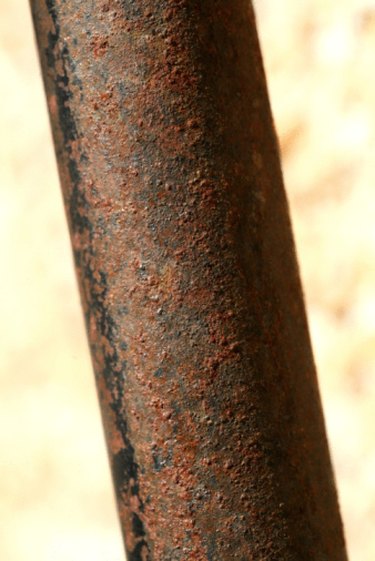
Steel poles are a common sight as flagpoles, railings and fences or supporting scaffolding or basketball nets. To fit and install any of these things, it may be necessary to cut a steel pole down to size. Since steel poles are typically hollow, cutting them is less work than it might appear from the thickness of the pole itself. That said, safely producing a clean and straight cut in a steel pole takes significant practice and skill. There are two basic ways to make such a cut: with a properly equipped saw or an oxy-acetylene torch.
Cutting a Steel Pole With a Saw
Video of the Day
Step 1
Fit your saw with a carbide blade. Carbide is an extremely hard material mixed into metal saw blades to allow them to cut steel and other metals. Although it is easiest to find circular carbide blades that fit on table saws and circular saws, carbide-tipped blades are also available for bandsaws and hacksaws at most home improvement stores.
Video of the Day
Step 2
Mark a line for your cut using a chisel or the edge of a saw blade.
Step 3
Secure the pole. If it is lying down, elevate the pole above your work surface and clamp a vise on either side of your cut point. If you are cutting a standing pole (such as one supporting a basketball net), have someone wearing safety gear hold the pole up and straight.
Step 4
Cut the pole. If using a circular saw, squeeze the trigger hard and push the saw firmly, evenly and slowly into the pole until it has cut all the way through. With a hacksaw, this will take much longer, as you will be relying on the power of your arms and hands. Start the cut with a few tentative strokes to build a groove along your cut line, then pull the saw back and forth hard to cut the pole. If the pole is small enough to fit in a bandsaw, set it across the bandsaw deck, start the saw, then get a good grip on the pole on either side of the blade and push it through firmly and slowly.
Step 5
Smooth the cut edges. Use a coarse file to take off any uneven burr left by cutting, then use a fine file and sandpaper to smooth the cut edges.
Cutting a Steel Pole With a Torch
Step 1
Remove any combustible material from your worksite. The sparks and flame from the torch could ignite it.
Step 2
Set up a box of sand or an extra piece of steel underneath your cutting site to catch the metal slag. If you have extra steel plate, set some up to protect your legs as well.
Step 3
Fit a cutting attachment to your torch of the size the manufacturer recommends for the thickness of material being cut.
Step 4
Adjust the torch's oxygen and acetylene pressure. Your cutting attachment will come with instructions that recommend settings for both.
Step 5
Put on goggles or a welding mask, protective gloves and a welding apron.
Step 6
Light the torch and adjust the preheating flame to neutral while leaving the cutting oxygen valve open.
Step 7
Grip the torch with one hand so that you have access to the oxygen control lever. Use your other hand to keep the torch steady and perpendicular to the steel being cut.
Step 8
Prepare to cut by following the line you marked a few times with the preheating flame. This will confirm that you can follow the line easily without straining when you actually cut.
Step 9
Start your cut. Hold the torch perpendicular to the steel with the flame just above its surface and wait for the spot underneath the flame to turn red-hot. When it does, squeeze the oxygen valve. There will be a shower of sparks at this point as the torch cuts through the steel.
Step 10
Move the torch tip steadily along the line you marked for cutting while squeezing the oxygen lever consistently. It should take 30 seconds to cut approximately 10 inches of steel. Moving too slowly will cause unnecessary melting along the cut, while moving too quickly will disrupt the reaction and stop the cut. If this happens, you will need to restart your cut from the point where you started moving too quickly.
Step 11
Release the cutting oxygen valve and shut off the torch.
Step 12
Knock the pole with a hammer to separate it if it doesn't break cleanly once your cut is done. Some of the melted material may stick in the cut, but it is brittle and will break easily.
Step 13
Smooth the cut edge with files and sandpaper once it cools.